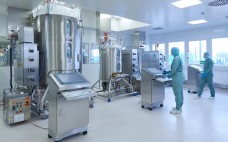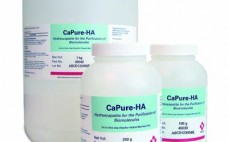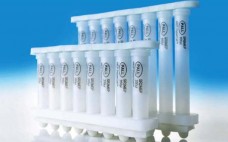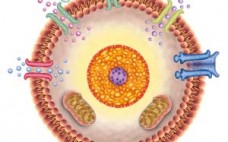Single-use technology have become indispensable in biopharmaceutical manufacturing. Rentschler is one of the first contract manufacturers worldwide to establish a complete single-use facility for the upstream and downstream processes.
BPI White Papers
CaPure-HAâ„¢: DoE Optimization of Elution Conditions
Design of Experiments (DoE), also called experimental design, is a statistical approach to process development that has gained wide acceptance in the biopharmaceutical industry. DoE is used to reduce development costs by speeding up the design process and to optimize the parameters of a particular step in the manufacturing process. The data presented here demonstrate the optimization of the CaPure-HA elution using a DoE approach.
Pressure Interruptions (Stop/Start) During Virus Filtration: Assuring Safety Using Robust Process Technology and An Appropriate Risk Mitigation Strategy
Following publications discussing the impact of pressure interruptions on the retention levels of virus filters, an increased focus is being placed on filter users’ own risk mitigation strategies. Users are increasingly requesting technical guidance and support with viral validation from filtration experts, as part of their overall product support package. This guidance document provides a high level of assurance to filter users by demonstrating how combining robust virus clearance technology with the use of standard operating procedures can assure a…
Sterile Vent Filtration on Ozonated Water Tanks
With many pharmaceutical processes requiring large volumes of water, it is critical that any pharmaceutical-grade water used is protected from particulate or microorganism contamination, in order to ensure that process operations do not become inadvertently contaminated. Several approaches can be used to ensure that water remains free from contamination, including the storage of purified water or WFI (Water For Injection) at a minimum temperature of 80°C to discourage microbial growth in the storage system. Another approach is to add ozone,…
Three Steps to Start You on the Path to Obtaining the Best Recombinant CHO Cell Line
When developing efficient, high quality biomanufacturing processes, it is imperative that the expression system (‘host cell line’ and ‘vector’) and the process to isolate and identify the best clonal cell line (‘clonal cell line development process’) are of the highest quality. At FUJIFILM Diosynth Biotechnologies a team of scientists has invested more than 20 FTE years undertaking innovation work which has culminated in the development of a new host cell line and vector, along with an optimised clonal cell line…
Computer-Aided Assay Development for Charge Heterogeneity Analysis by iCE
Unlike chemically synthesized drugs, protein therapeutics are a dynamic heterogeneous mix of active compounds. Due to their complexity, analytical techniques like isoelectric focusing have become indispensable tools in evaluating biologic preparations. The resulting surge in charge isoform analysis has led to major advances in instrumentation, such as Imaged Capillary Electrophoresis (iCEâ„¢)2 . However, to obtain the full benefit from improved instrumentation requires the coinciding development of robust assays. The goal of this note is to promote the successful application of…
Use of ScreenExpert RoboColumns for High Throughput Study of Loading Conditions on HyperCelâ„¢ STAR AX and MEP HyperCel Sorbents for MAb Purification in Flow-Through Mode
The use of HyperCel STAR AX and MEP HyperCel sorbents for MAb polishing provides efficient contaminant removal. A study to screen loading conditions for MAb purification in flow-through mode on MEP HyperCel and HyperCel STAR AX sorbents was conducted using 200 μL ScreenExpert RoboColumns. The study demonstrates the suitability of ScreenExpert RoboColumns for scale down evaluation of chromatographic parameters, and the good consistency with data obtained on 1 mL PRC prepacked columns. ScreenExpert RoboColumns allow loading of high sample volume…
Implementation of Mustang® Q Membrane Chromatography as a Polishing Step (Residual DNA Removal) in Monoclonal IgG1 Production from CHO Cell Culture
In collaboration with ProBioGen AG, Berlin, Germany, Mustang Q membrane chromatography was evaluated as a polishing step following protein A affinity and cation exchange chromatography to remove residual host cell DNA during a Monoclonal antibody (MAb) purification process at 250 L cell culture production-scale. Data indicated efficient DNA clearance by the Mustang Q membrane chromatography step during the process (96%). Additionally, contribution of the Mustang Q membrane chromatography polishing step to HCP removal was shown. Based on a virus-spiking scale-down…
Flow Electroporation Capabilities and Case Studies: Rapid GPCR Screening and Functional Ion Channel Assays
MaxCyte’s proprietary flow electroporation technology has been successfully applied in ex vivo cell therapy (1) and drug discovery pipelines where reproducibility, efficiency and the need for increased cell numbers are critical. This technical paper discusses the merits of transient transfection using flow electroporation versus other recombinant expression approaches and its application in hit identification and lead optimization programs. Data are presented demonstrating the key features of the MaxCyte® STXâ„¢ Scalable Transfection System, including broad applicability, scalability, and the production of…
Delivering Fit-for-Purpose Biomanufacturing CHO Cell Lines
A prerequisite for the successful manufacture of a biopharmaceutical in mammalian cells is a cell line development strategy that selects a cell line with the most desirable properties from a heterogeneous transfectant population. Desirable attributes include the stable, high expression of product with the appropriate critical product quality attributes rapidly, reproducibly and with relative ease. Obtaining a host cell line that inherently exhibits such desirable biomanufacturing attributes can therefore have a significantly positive effect on the identification of recombinant cell…










